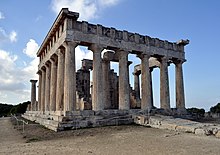Ναός Αφαίας (in Greek) | |
 Temple of Aphaia from the southeast. | |
| Location | Agia Marina, Attica, Greece |
|---|---|
| Region | Saronic Gulf |
| Coordinates | 37°45′15″N 23°32′00″E / 37.75417°N 23.53333°E |
| Type | Ancient Greek temple |
| Length | 80 m (260 ft) |
| Width | 80 m (260 ft) |
| Area | 640 m2 (6,900 sq ft) |
| History | |
| Founded | c. 500 BC |
| Periods | Archaic Greek to Hellenistic |
| Satellite of | Aegina, then Athens |
| Site notes | |
| Condition | Erect with collapsed roof |
| Ownership | Public |
| Management | 26th Ephorate of Prehistoric and Classical Antiquities |
| Public access | Yes |
| Website | Hellenic Ministry of Culture and Tourism |
The Temple of Aphaia (Greek: Ναός Αφαίας) or Afea[1] is an Ancient Greek temple located within a sanctuary complex dedicated to the goddess Aphaia on the island of Aegina, which lies in the Saronic Gulf. Formerly known as the Temple of Jupiter Panhellenius, the Doric temple is now recognized as having been dedicated to the mother-goddess Aphaia. It was a favourite of Neoclassical and Romantic artists such as J. M. W. Turner. It stands on a c. 160 m peak on the eastern side of the island approximately 13 km east by road from the main port.[2]
Aphaia (Greek Ἀφαία) was a Greek goddess who was worshipped exclusively at this sanctuary. The extant temple of c. 500 BC was built over the remains of an earlier temple of c. 570 BC, which was destroyed by fire c. 510 BC. Elements of this older temple were buried in the infill for the larger, flat terrace of the later temple, and are thus well preserved. Abundant traces of paint remain on many of these buried fragments. There may have been another temple in the 7th century BC, also located on the same site, but it is thought to have been much smaller and simpler in terms of both plan and execution. Significant quantities of Late Bronze Age figurines have been discovered at the site, including proportionally large numbers of female figurines (kourotrophoi), indicating – perhaps – that cult activity at the site was continuous from the 14th century BC, suggesting a Minoan connection for the cult.[3] The last temple is of an unusual plan and is also significant for its pedimental sculptures, which are thought to illustrate the change from Archaic to Early Classical technique. These sculptures are on display in the Glyptothek of Munich, with a number of fragments located in the museums at Aegina and on the site itself.[4]
- ^ The name Afea appears on all the local signs, Afea being the name of a Cretan woman of unsurpassed beauty. After escaping an unwelcome marriage on Crete, she was rescued by a fisherman from Aegina. In payment for this he also proposed an unwelcome marriage. So Afea headed out of Aghia Marina towards the mountain top where she vanished at the current site of the temple, where it is said that the fisherman established a shrine believing Afea to have been taken by the gods.
- ^ The main port and the main city are named Aegina, after the island. The Temple of Aphaia is 9.6 km east of this city. The sanctuary is also 29.5 km southwest of the Acropolis of Athens, which is visible across the gulf on a clear day.
- ^ Pilafidis-Williams argues that the character and relative proportions of the finds leads to the conclusion that the deity worshipped was a female fertility/agricultural goddess.
- ^ The important Bronze Age archaeological site of Kolona is northwest of Aegina (the main city) along the coast, and a museum is located at this site. The museum at Aegina was the first institution of its kind in Greece, but most of the collection (other than a collection of bas relief panels from Delos) was transferred to Athens in 1834 (EB), where it can be seen in the National Archaeological Museum of Athens. The museum on the site contains a restoration of the Early Archaic temple entablature and pediment, as well as copies of elements of the pedimental sculpture of the Late Archaic temple set into restored sections of the pediment.
